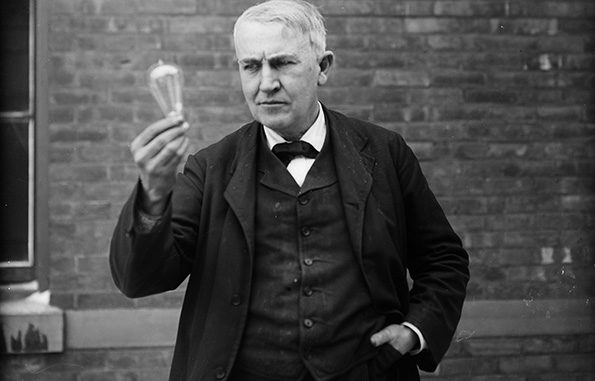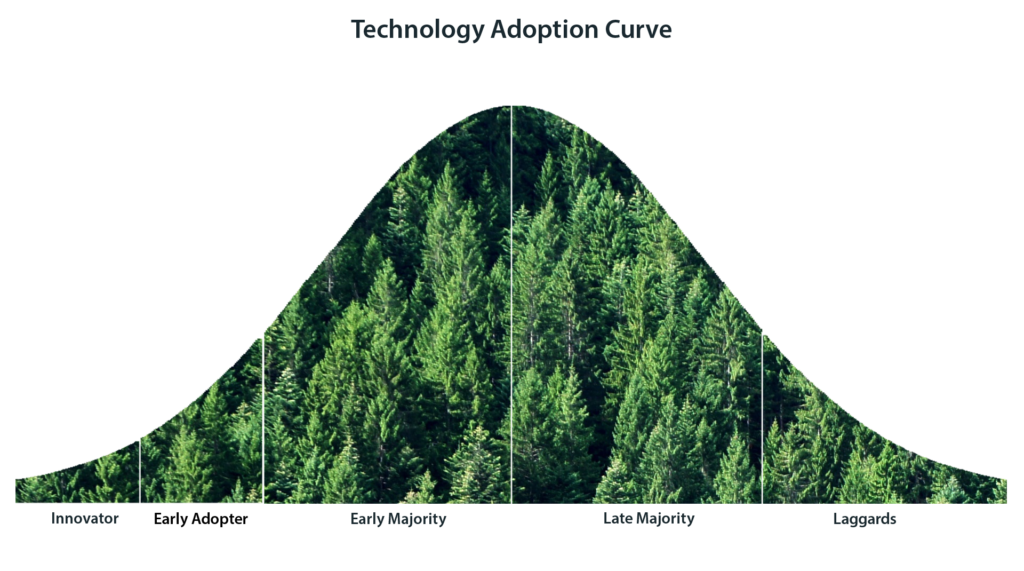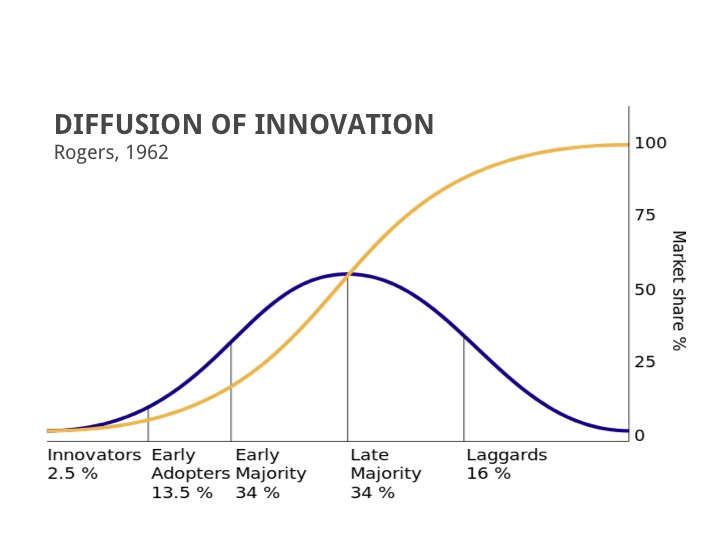Introduction
You may have noticed that important innovations often take a long time to be adopted. For example, it took 40 years to reach one million solar installations in the U.S. (!!) In a world confronted by a seemingly infinite array of issues, we must find ways to accelerate the adoption of new products.
I’ve spent over 50 years researching and understanding how people adopt new products and ideas into their lives and I’ve been able to identify the following 10 factors that have the largest influence on technology or innovation adoption. Use these as a checklist when preparing to launch your new product or service.
1. Minimize Disruption
Most of us think of Thomas Edison as an inventor. But if you look closely, you’ll see Thomas Edison also had an expert understanding of technology adoption and social diffusion. Edison’s first public demonstration of his incandescent light bulb was on December 31, 1879. And in 1882 Edison dramatically accelerated the adoption of electric power and light to the early majority using specific techniques designed to humanize his new invention.
Edison’s strategy for accelerating the adoption of electric light was based on minimizing disruption to people’s lives. Since gas lamps were the dominant method of indoor lighting, Edison designed his electric lights to look and operate almost identically. His initial electric lights provided 13 watts of light, almost the same as the 12-watt gas lamps he wanted to replace. The form factor of Edison’s new electric lamps was very similar to gas lamps.
Recognizing that many commercial and residential landowners in New York had invested considerable capital in gas infrastructure to light their buildings, Edison chose to run his first electrical wires through existing gas lines, fitting directly into the system people already understood for the delivery of light.
Edison’s technology was new, but the form and function were decades old. In fact, Edison’s strategy of adapting his technology to systems people were familiar with, and minimizing disruption of the customer’s habits, led to accelerated acceptance and adoption.

2. Solve a Meaningful Problem
Promising new innovations often fail because the promised change isn’t really compelling from a hearts-and-minds perspective. A meaningful problem leads to a sense of purpose and that’s where good ideas and innovations really come from. Successful change agents feel strongly that the problems they are working on need to be solved, and revolutions begin with a cause.
You need to uncover problems related to your business, your customers and in new emerging markets. That’s one thing that truly great innovators do differently. They constantly seek out and solve important problems that people care about.
The best innovations come in response to a meaningful problem.
In larger organizations people can be motivated by financial projections and share price, or their incentive compensation. But other people need different sources of meaning. You need to solve a problem that’s meaningful to everyone. So don’t look for a great idea, find a problem that matters.
3. View Your Audience As a Whole
Your success as a change agent depends not only on coming up with great ideas and making them happen, but also with getting those ideas adopted by your target audience.
Whether it’s the buying public, a trade association, or just your direct supervisor, getting your concept off the drawing board and into the world is perhaps the most important (and difficult) part of meaningful innovation.
So how can you improve the chances of getting your great idea adopted? In 1962, Everett M. Rodgers published Diffusion of Innovation (where he coined the term “early adopter”) the end result of a large-scale research project on why innovations spread. Rogers, then a sociology professor at Ohio State University, gathered the results of over 500 hundred studies on why innovative ideas are adopted among people and organizations.
Diffusion of innovations is a process that occurs through a social system. The social system has five “adopter” segments that fit a normal distribution. The segments move from left to right over time in order of adoption: (1) innovators, (2) early adopters, (3) early majority, (4) late majority, and (5) laggards.
The groups move in this progression because each group has attributes that make it more (or less) open to change. Obviously, innovators are the most open, and laggards are the least. With the exception of the innovators, each group adopts an innovation by observing experiences of the adjacent reference group. As favorable observations and refinements accumulate, adoption spreads through the entire social system.
Countless books and articles have been written about the theory and its application in various industries. Some even discuss the idea of a gap between categories of adopter segments. Unfortunately the labels assigned to each adopter segment — innovator, early adopter, early majority, etc. — imply each segment is totally independent and should be viewed in isolation.
Many of the difficulties surrounding meaningful innovation and change can be traced to the fundamental error of focusing on the people who adopt an innovation first, rather than on the whole of society.
Gestalt is a concept in the field of psychology that says the whole of anything is greater than the sum of its parts. That is, the attributes of a market or population cannot be derived from analysis of the parts in isolation.
Gestalt Reinvention explains how innovations are taken up in a population, using an integrated view of society. The success of meaningful, new innovations is often hampered or even permanently blocked by the fundamental error of focusing on segments of society (groups of trees), rather than on society as a whole.

4. Plan for Significant Upsets and Transitions
In order for innovative new products to achieve mass-market appeal, they must be refined and improved by a sequence of users, starting with innovators and early adopters. This dynamic, called Diffusion of Innovations is critical to the success of any emerging product or technology. Without the adaptation and improvement that’s demanded by early users, mainstream customers (over 80% of the market) will not adopt your new product.
When taking your new product to market, early adopters can be your biggest supporters, friends and allies provided you remember one thing: visionaries are not looking for gradual improvement, they are looking for a fundamental breakthrough. Early adopters are people who have the insight to match a new innovation to a strategic opportunity, combined with the temperament to translate that insight into a high-visibility project.
These “change the world” characteristics of early adopters can literally launch your company. Early adopters sometimes represent a hidden source of financial capital, and always bring much-needed visibility to any startup.
Unfortunately all methods of marketing to early adopters will fail miserably for you in the future. The visionary characteristics of your early customers are in direct opposition to the characteristics of mainstream customers. Instead of looking at how an innovation can create a strategic leap forward, mainstream buyers have a more pragmatic view of the world and they worry about all of the things that could possibly go wrong through the adoption of a new product.
This means moving from early adopters to mainstream customers will force a massive transition on you and your company. Just as your company has learned how to market and sell to early adopters, a big shift in customer characteristics occurs and you must re-learn everything.
Early majority and mainstream customers are less concerned with the vision, or leadership, or making a quantum leap, and more concerned with practical results. In approaching a new set of customers with a different mindset, managers of new innovations must to be ready to look at their entire strategy — product, messaging, and distribution — with a fresh perspective, and be willing to embrace change across the board.
5. Attributes Determine the Adoption of a New Product
Customers view products very differently than the people who create or supply them. In technology-based companies the tendency is to try to sell products on the basis of price, special features and technical specifications. The engineers and scientists who typically run high-tech companies often favor these technical factors. The problem is that most customers consider factors such as product support, industry standards and company reputation to be more important. So the feature rich products created by techies are seen as incomplete in the mind of the customer. Rapid adoption of a new product comes from focusing on the “intangible” factors that are especially attractive to most customers.
Sony applied the whole product concept and took advantage of digital photography’s lack of standards (which are very important to non-technical buyers). Among Sony’s digital competitors, there were at least five non-interchangeable storage systems. Sony designed its Mavica camera to work with a known, standard storage device…the floppy disk.
Despite being more expensive, clunkier, and less capable (it didn’t produce the sharpest pictures) the Sony Mavica was the top-selling digital camera in the U.S. While competitors like Casio were all concentrating on picture resolution, Sony focused on meeting the needs of mainstream buyers.

In some cases it is better to reposition your new innovation into a supporting element of some other complete offering. This is what Apple did with their laser printer. They bundled the Apple LaserWriter with page-layout software (called Aldus PageMaker) and the Macintosh computer, and sold it as a “desktop publishing system.” Making someone else’s product more complete is often the best strategy.
6. Provide Either Trialability or Observability
Trialability refers to the ease of sampling a new product and its benefits. The more potential users can test a product or view it in operation, the more likely you will accelerate the adoption of a new product.
Observability on the other hand is the noticeable results of trying or consuming an innovation. When new products are highly visible, it drives more people to share it and increases the likelihood of mass adoption. When trialability is not possible, observability becomes necessary.
Enterprise IT solved the trialability issue with cloud computing. The cloud enables a try-to-buy sales cycle that reduces the risk of the buyer in testing the new product. So it is much easier to get started, and thanks to companies such as Amazon and Rackspace, scaling after testing is very easy.
The same is true for the software-as-a-service (SaaS) business model. Before SaaS, customers had to purchase a software package and then make their use of it successful. In effect, the customer had to bear all of the “adoption risk.” SaaS transfers that risk from the buyer to the vendor and makes it easier for customers to buy in to next-generation offers.
In the green building industry observability becomes the best approach. Because it’s not so easy to take new school buildings on a test drive before you buy, The New Buildings Institute has created the Getting to Zero School Watch List, which allows school administrators to identify other nearby schools that have implemented net-zero energy projects.
Prospects use those as regional examples to help convince school decision makers to pursue ultra-low and zero energy construction.

7. Develop an Integrated Ecosystem
Innovators usually become so wrapped up in what they’re developing that they overlook all the other elements necessary to make delivery and experience of the offering successful.
Thomas Edison [again] created the electric light bulb and then wrapped an entire industry around it. The light bulb is most often thought of as his signature invention, but Edison understood that the bulb was little more than a showy apparatus without a system of electric power generation and transmission to make it truly useful. So he created that, too.
Thus Edison’s genius lay in his ability to conceive of a fully developed marketplace, not simply a discrete device. He was able to envision how people would want to use what he made, and he engineered toward that insight. He gave great consideration to users’ needs and preferences.
Edison’s approach was an early example of what I call “gestalt reinvention” which is a methodology that is based on a thorough understanding, through direct observation, of what people want and need in their lives and what they like or dislike about the way particular products are made, packaged, marketed, sold, and supported.
8. Align Your Communications Activities and Messages
The psychological characteristics of your audience will change over time so everything you do had better change to match your audience. And those involved in new product development and innovation must learn the unique marketing “language” of each adopter category sequentially.
The process begins by defining each category along the adoption lifecycle and what makes them unique, keeping in mind that there are always exceptions. As your innovation moves through the adoption lifecycle, the area of greatest value to the customer changes. In the early market, the highest value is placed on technology and product. In the mainstream, the highest value is placed on market and company. This represents a transition from product-based to market-based values. As innovations move through the life cycle, the value domains change, and thus communications must change to shape, reflect and reinforce such values.
Your communication strategies must evolve relative to market development. This includes the specific messages and media required to execute a market development strategy. Effective communication revolves around understanding the drivers that motivate decisions made by each stakeholder.
In the school market for example, student educational outcomes are the primary driver of stakeholders. Framing messages [about net-zero energy buildings] with this driver in mind is key to communicating with them on a level that they understand and that motivates them. In addition, most audiences are not very technical so focusing on outcomes rather than the technical way Zero Energy will be achieved may be a more successful strategy.
9. Reduce the Perception of Risk
The success of an innovation depends on how well it evolves to meet the needs of more and more risk-averse individuals in a population.
The psychographics of each group in the adoption process influences the development and dynamics of a market. Each group places a different value on product intangibles, and on endorsements or references from other groups. As products move through the adoption process, intangibles and user references assume more importance. Also critical to understanding the adoption process is the underlying motivation of each group. Innovators for example love to be first to try something new. Whereas early adopters are motivated by their desire to transform their company or life into something much better.
Decades of research show that the characteristics and motivations of mainstream buyers are consistent regardless of the technology or innovation that is being adopted. Before a pragmatic, mainstream buyer adopts a new product it must meet the following requirements:
- The product must be evolutionary, not revolutionary
- The product must enhance the system the buyer has now, not overthrow it
- The product must improve an existing operation, not change it
- The product offering must be a complete solution (or include an integrated ecosystem)
- The buyer must not be required to fine tune or troubleshoot the product
- The product must work properly and integrate easily with the exiting infrastructure
- The vendor cannot disappear after installation
- The product or system must be purchased from a market leader
- The vendor must provide references and/or referrals from an identical type of customer
Given that 84% of the population looks for ways to avoid risk, “the Low Risk Recipe” above is a concept that describes the socially acceptable methods of accelerating change. This framework for the delivery of low-risk solutions can be applied to accelerate the acceptance and adoption of any type of innovation.
10. Avoid “Early Adopter Disease”
High-tech equipment is generally used over an extended period of time, is integrated with complimentary products, and imposes learning costs on the end user. As such, customers require time to digest and recover their investment in high-tech products and the overall systems in which the products are used. The rapid introduction of new and improved versions can make a customer regret a previous purchase, delay all new purchases, and agonize over similar purchases in the future, none of which are in the long-term interest of the producer.
When taking your new innovation to market, early adopters will be your biggest supporters. They see the world the same way as innovative entrepreneurs, and early adopters are happy to be the first to try something new. To boost the initial sales of your new product or technology, you will probably use “visionary” marketing tactics that are immediately attractive to early adopters.
The fatal mistake managers make is assuming all customers have early-adopter personalities and characteristics. Unfortunately, the familiar characteristics of your early customers are in direct opposition to the characteristics of mainstream customers. So the reluctance to see future customers as fundamentally different, and the tendency to treat all customers as early adopters, combine to give you the early adopter disease, which is fatal.
Avoid the common mistake of leaving mainstream customers behind. Many high tech companies ASSUME their target audience has the technical skill needed to adopt and utilize a new product. Unfortunately, many of the technologies we see in the world today actually leave more people behind than they pull forward. So the market adoption you were planning on (which is driven by word of mouth) doesn’t materialize because significant numbers of people are saying negative rather than positive things about you.



